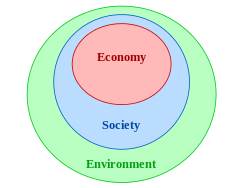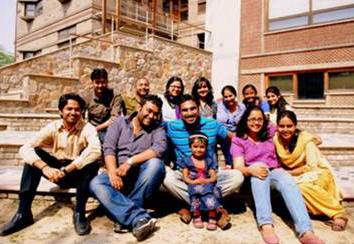|
Role of Youth in Environmental Sustainability
Background "Give me just one generation of youth, and I’ll transform the whole world" Vladimir Ilyich Lenin T he world as we know it today is an unsustainable place. Pollution and poverty have thrown our planet into a downward spiral. We have truly made a mess of things. The only way to make the earth a better place for generations to come is to implement a more sustainable way of life.In ecology this word describes
biological systems that remain diverse and productive over a long period
of time. Healthy wetlands and forests are prime examples of sustainable
biological systems. For humans sustainability has economic,
environmental and social dimensions. These are the three pillars of
sustainability. Economic issues - If a community does not have a flourishing economy, it will not be able to achieve sustainability over a long period of time. Environmental Issues - A community can be sustainable only when it takes care of its environment. Social issues - A community must address its social issues otherwise it will not be in a position to bestow the necessary attention to protect its environment. If these three pillars are not strong, the community is bound to collapse. Our planet has plenty of natural resources but the demand for these resources is increasing by the hour. Sooner or later they will be exhausted. As Mahatma Gandhi once said "Earth provides enough to satisfy every man's needs but not every man's greed." It is high time that we analyse our needs and decide what our true priorities are. Nowadays flexibility and dynamism are more relevant than ever before. With stressful lives and decreasing amount of leisure time we want to go from one place to another as fast as possible. But this desire for saving time puts a major strain on the environment. What alternatives are available to us in terms of eco-frendly transport? And how can we reduce dependence on the finite resources, such as oil, in the transport sector? The solution lies in using bicyles and public transport. Engaging youth in organised
efforts to promote environmental sustainability has important
implications for youngsters themselves as well as for their communities.
Every third person you meet in an Indian city today is a youngster. In
about seven years the median age of a person in India will be 29 years,
making
The Indian youth have both special concerns and special responsibilities in this context. A number of environmental risks and hazards will affect those who have to live for an extended period in the deteriorating environment bequeathed to them by the earlier generations. The nature, extent and severity of environmental problems vary tremendously from one part of the world to another but certain issues-most notably global warming and ozone layer depletion-are global problems and therefore of concern to everyone. The role of youth in creating environmental awareness In politics, youth, as a constituency, can make their influence felt by calling political leaders to account for the long term environmental consequences of their decisions. Environmental education is one way of equipping young people with necessary cognitive skills to recognise and withstand the pressure of commercial advertising. It is important to guide them on how to draw links between a given product, often attractively advertised, and its ecological impact. Advertisers are extremely skilled at disseminating messages suggesting that their products and activities are environmentally sound or even beneficial. This process is known as "green washing". It occurs when, for example an automobile company markets "green sports utility vehicles" or when a lumber firm logging in old-growth forests styles itself as "the tree-growing corporation". Young people with a stake in
the more distant future are especially well-placed to promote
environmental awareness. Anti-ecological ways of thinking and behaving
have not yet been fully ingrained in them so they can approach these
issues with fresh ideas. At the same time much of the environmentally
relevant information young people receive comes not from formal
education but from the media. In principle, formal environmental
education and the media could join in the larger process of social
education, though the fact that the media are generally driven by other
concerns can get in the way of such a synthesis. Even then the media can
be a powerful tool for education.
Strengthening participation of youth in environmental protection One aspect of the innovative approach is the extent to which contemporary social movements are now transnational in character. They organise networks that span the globe, for example, the network against biopiracy. Aside from political action, there are possibilities for youth participation in practical environmental projects. Camps such as ‘Rural Youth Immersion Programme’ conducted by Development Alternatives (DA), encourages green innovations through Social Entrepreneurship Programmes, creating opportunities through Green Internships. The participation of youth in environmental protection can be sought at levels ranging from grass-roots activism to policy-making bodies and Non-Government Organisations (NGOs). Their role can be institutionalised in policy-making through advisory bodies such as youth councils. Many national governments have ministries or departments of "youth affairs". In addition to their intellectual contribution and ability to mobilise support, young people bring unique perspectives that need to be taken into account by the government. Majority of Indian youth come from rural India where obtaining basic amenities of life continues to be a matter of concern. In such a challenging situation where immediate issues like livelihood and food are of primary importance, sustaining the support of young people is bound to be very difficult. That’s why they need to be trained in sustainable ways of living through vocational workshops that would empower them to fulfill their requirements without being harsh on the environment!! The present day youth knows that this is not the time to sit back and expect things to change by themselves. Therefore almost every day we hear about a new movement for or against various environmental issues, ranging from deforestation to discouraging animal ill-treatment. In the current situation of the environment awareness is bliss. These are the harbingers of the new age when India would not only be known for its cultural and geographic diversity but also as a country that prides itself on actively maintaining and upholding ecological balance through sustainable development. A Modern Youthful India!! "The activist is not the man who says the river is dirty. The activist is the man who cleans up the river." ~Ross Perot References : UN Habitat Report on State of Urban Youth 2012; Draft National Youth Policy 2012; The Ocean in a Drop- Ashraf Patel and others; Youth and the Environment -World Youth Report 2009; online references from http://iisd.ca/youth/ysbk088.htm q Ranjeeta Ghosh
|

 us
the youngest nation in the world. Over the last two decades, India has
firmly established itself in the world economy.
us
the youngest nation in the world. Over the last two decades, India has
firmly established itself in the world economy.